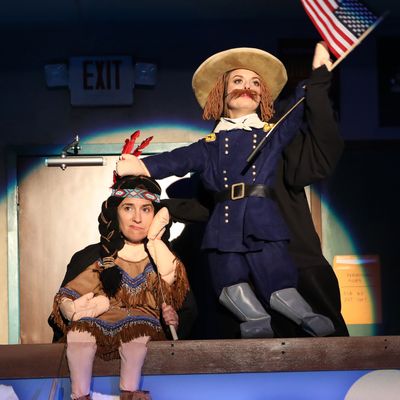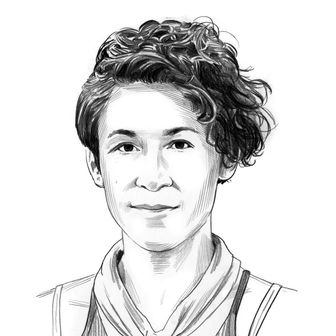
The Thanksgiving Play is one of those truly distressing experiences that make you feel like you’re caught in the theatrical Twilight Zone — because what you’re seeing is so vastly, painfully out of step with what its creators seem to have intended. According to her “From the Playwright” note in the show’s program, Larissa FastHorse thinks that she’s written “a really funny comedy. Like a laugh out loud so much that it’s gonna add minutes to your life comedy. (You’re welcome.)” She also says that her play “is just real people, primarily liberal, well-meaning folks that we all know and love and are. Like us, they are deeply flawed and fighting for things with a ferocity that is beautiful and tragic.”
It seems like my theme this week is going to be good intentions. FastHorse may have had them, but The Thanksgiving Play is neither funny nor humane. Its humor is snide and forced — you can hear audience members start to laugh fitfully because they desperately want to, and they’re trying to do that “leap and the net will appear” thing — and its characters are cartoonish burlesques, contemptuously rendered. I wouldn’t be surprised if the play’s four actors are bone-exhausted at the end of each show, despite the 90-minute running time: These characters give nothing back. Not beauty, not tragedy, not comedy, barely even personality.
They are four teaching artists in an American public school of uncertain whereabouts — “anywhere but the Los Angeles area,” says the script. Their leader, Logan (Jennifer Bareilles) — a high-school theater teacher with supercharged anxiety and an unexplained “300-parent petition to fire [her]” — has received the “Native American Heritage Month Awareness Through Art Grant.” She and her romantic and artistic partner Jaxton (Greg Keller) are preparing to create a work of devised theater genius that will undo the whitewashed Thanksgiving mythos, break down all the “misguided governmental policies and historical stereotypes about race then turn all that into something beautiful and dramatic and educational for the kids.” Their corrective pageant is intended for elementary-schoolers, but the grant has enabled Logan to hire Alicia (Margo Seibert), a professional actress from L.A. who can provide the “Native perspective.” Also onboard is Caden (Jeffrey Bean), the group’s research man, an enthusiastic schoolteacher with theatrical aspirations but none of his younger colleagues’ pretensions to hipness or ostentatious political sensitivity. He’s just a good old-fashioned nerd.
Thank God for Caden, who’s the only almost–human being in The Thanksgiving Play. Though FastHorse still pushes the character toward stereotype — especially in his dopey crush on Alicia, which feels trite and gratuitous — Bean manages for the most part to steady him, giving him a hint of sympathetic personhood that none of the caricatures around him attain. Director Moritz von Stuelpnagel is milking the comedy as hard as he can, but the cow is dry, and in the process he’s pushing Bareilles, Keller, and Seibert into the kind of parody where the zaniness feels ungrounded and lifeless.
The initial joke — which you can see coming all the way from anywhere-but-L.A. — is of course that Alicia, like everyone else in the story, is white. After tying themselves in knots attempting to address her correctly, to “hold space” for her and ask her about her family’s traditions (giving her ample chance to reveal herself as a vapid Valley Girl), Logan and Jaxton are horrified to discover that the actress uses “headshots as six different ethnic people, which [have gotten her] many roles,” such as the understudy for Jasmine in the Aladdin show at Disneyland. Seibert has to hair-flip and blink dreamily and drink LaCroix and stare at the ceiling, cheerfully flouncing around in breezy Urban Outfitters duds and Prada sunglasses and equally cheerfully admitting to Logan that she’s “not that smart… No, really, I’m not. I’ve been tested” — a punch line that, like many of FastHorse’s jokes, isn’t just unfunny but verging on mean. Alicia is a life-size Malibu Barbie, and yet, like Caden, she’s marginally easier to feel for because she has no grand illusions about herself. It’s with Logan and Jaxton, the well-meaning “woke” folks, that FastHorse really goes for the kill, giving Bareilles and Keller nothing to play but fools.
Logan is so strung out on phrases like “I want to lift up the acknowledgement that…” and “Coded language is an issue we need to be conscious of” that she twitches like a righteousness junkie. But of course her ultraprogressive résumé — “I got the Gender Equity in History Grant, the Excellence in Educational Theater Fellowship, a municipal-arts grant, and the Go! Girls! Scholastic Leadership Mentorship” — masks an insecure failed actress, a mousy smart girl who gave up after six weeks in L.A. and stares at hot, dim Alicia with a mixture of superiority and wistful envy. She’s such a self-immolating stressball that how she’s ever made it through directing a show is a mystery. Oh, and she’s also a vegan, because why not go for the low-hanging vegetables.
Jaxton’s even worse. He’s a “vegan ally” (he’s an everything-ally) and self-described “actor–slash–yoga dude” who does street performance at the farmer’s market, talks about Burning Man and Tantric sex and meditation, says “I hope to Buddha…”, and gives Logan a “water bottle … made with recycled glass from broken windows in housing projects” to celebrate their first rehearsal (it’s a Mason jar). The pair do an absurd “decoupling” ritual before beginning work, in order to enter a zone of “gender-neutral actor-director respect.” Keller is basically doing something that lands between early Keanu Reeves and Hansel from Zoolander. His voice is I-just-took-a-bong-hit scratchy, his eyes are half-closed, and when Logan finally loses her temper with him, he marvels in “Whoa, dude” tones: “I think this is what ‘less than’ feels like … And that is a profound gift. Do you know how hard it is for a straight white male to feel ‘less than’ in this world? I don’t know that I’ve ever truly felt it in my life.”
I wrote recently about the difficulty of satire that hasn’t located its heart. That’s why Christopher Guest’s movies and shows like Parks and Rec are so effective and hilarious: They love the people they’re poking fun at. And we love them too — we see their humanity and their absurdity, and how the Venn diagram of the two is really just a pair of almost completely overlapping circles. (Wilson Chin’s scenic design actually has a sense for this: The funniest things in the show are the posters for earnest high-school productions of plays like The Crucible and Angels in America that line the walls of the play’s classroom set.) Despite FastHorse’s program note, I sensed no real creator’s affection for the characters of The Thanksgiving Play. From the very beginning they’re paraded out as insufferable stereotypes, dense and misguided in ways that seem so obvious that we can neither feel for them nor learn from them. They possess so little capacity for real self-awareness that the play ends up having nowhere to go. It reaches a few crescendos of forced farce — with lots of running around and screaming and spraying seltzer water at each other, oh, and plastic, bloody decapitated Native American heads (where the hell did they get these? Were they lying around the theater-classroom props closet?) — but FastHorse hasn’t figured out how to make her characters grow and change, so the whole endeavor feels dull and arcless. It feels less like an investigation of the absence of indigenous people in the national and historical narratives, and simply like an hour and a half of “Look at the dumb white people.”
FastHorse is a Sicangu Lakota playwright, and has spoken about writing The Thanksgiving Play in part as a response to theaters telling her that they couldn’t find casts for plays with too many Native American roles. “So I set myself the challenge of writing a completely castable play,” she told the Interval. “I decided to write a play with all people who could be mistaken for white — and they do not necessarily have to be white, they are not all playing white, but they could all be mistaken for white folks — but that still deals with the issues of what it means to be a contemporary Indigenous person in America.” I’m not even sure how to parse what’s between the em-dashes there. If The Thanksgiving Play’s characters don’t see themselves as white, why is the entire play a dance around their white guilt? Why don’t they ever speak about themselves and their own sense of identity? If it’s possible that actors of color might play these roles, why are they written as white cartoons? The Thanksgiving Play begins with a powerful premise, which is to underline the erasure — sometimes violent, sometimes well-meaning — of Native Americans in both the history and the present of this country. But it has made that point by the time you get through reading the play’s marketing blurb. There still has to be a play, and a play, even the darkest satire, needs not only a target but a heart.
The Thanksgiving Play is at Playwrights Horizons through November 25.


